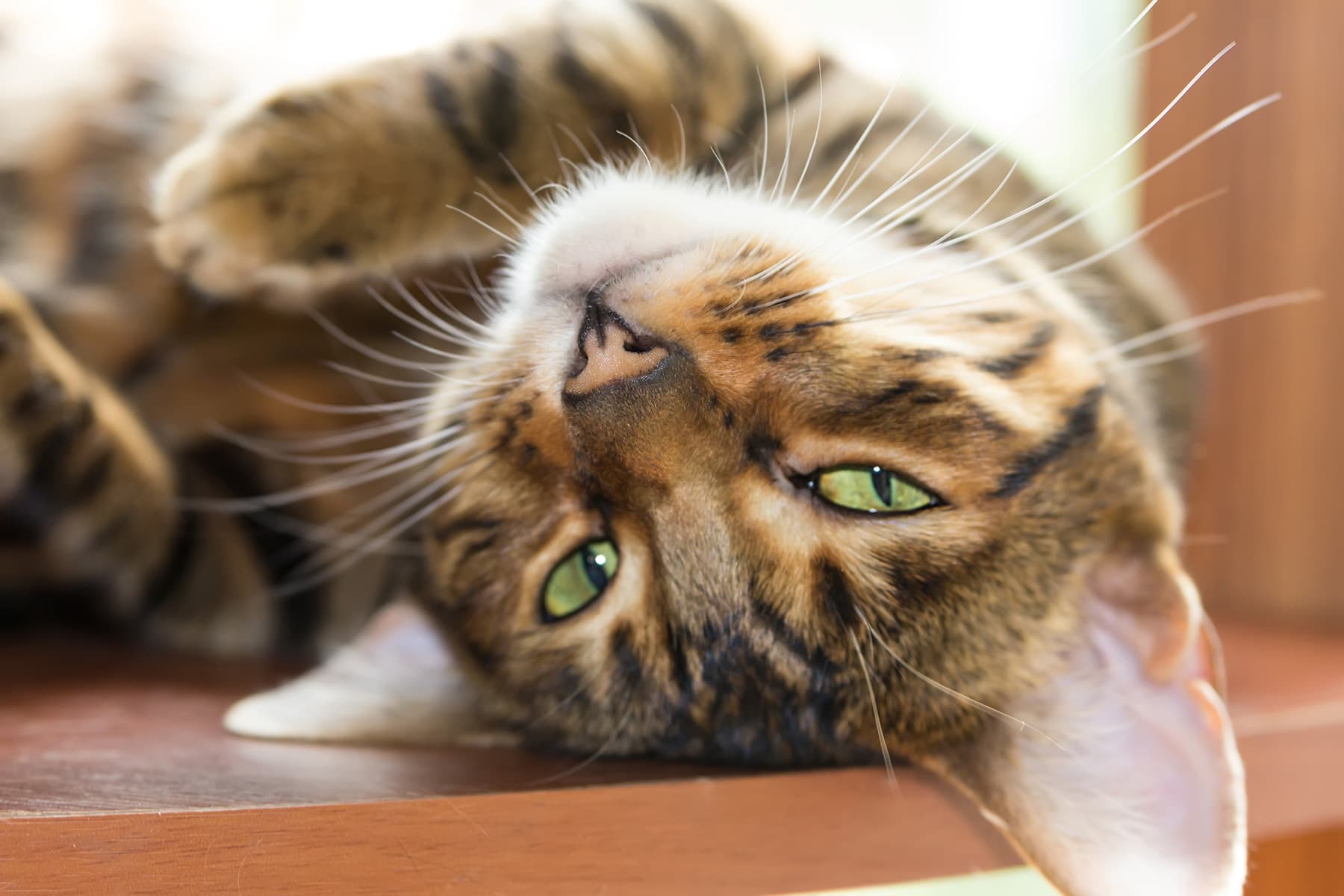
The Toyger cat looks like a tiny tiger — a toy tiger, to be exact. These house cats have a striped coat that resembles the distinctive markings of the largest cats in the world. That's where the resemblance ends, fortunately. Toygers don't share bloodlines with their wild counterparts, and they aren't dangerous. The eye-catching pets are descended from kittens born in the 1980s after a cat breeder crossed her pet Bengal cat and striped shorthair cat to see if she could replicate tiger stripes. The breed has grown in popularity in the decades since the first Toygers were born.
Toyger Characteristics
Toygers are eye-catching pets because of their distinctive coats and glittered fur. While they are descended from domestic cats, they were bred to resemble wild tigers in their looks and how they move.
Physical traits: Toygers are recognizable by the tiger-like stripe pattern that covers their whole body. Unlike typical tabbies, their stripes branch out in a bold pattern over an orange-toned background. Toygers also have a circular stripe pattern on their heads, which is unique among domestic cats but similar to wild tigers. The cats are lean and long-bodied like tigers, with long heads and small, tiger-like eyes. Their legs keep them low to the ground, so their walking gait resembles the movements of their wild counterparts. The usual Toyger size is similar to a medium house cat; they usually weigh under 15lbs. They are a long-lived breed; a Toyger lifespan can be 13 years or more.
Toyger personality: Toygers were bred to be companion pets, so they have an easygoing nature. They are usually characterized by positive personality traits such as a pleasant temperament, relaxed personality, intelligence, trainability, and ease of handling. They are content to live among humans, including children. They seek out human attention and enjoy playing and following people around the house. They can get along with other animals in the home as well.
Caring for Toygers
Caring for a cat means providing them with the appropriate feeding, grooming, and vet care. Toygers are relatively low-maintenance cats in terms of physical care. Toygers have short coats that are easy to keep clean. They thrive on a typical house cat diet, so their day-to-day needs aren't complicated. A healthy Toyger only requires periodic vet care, much the same as any other domestic cat.
Coat care: Toygers have short, thick, velvety coats that don't require complicated maintenance. Periodic brushing keeps their fur looking shiny and accustomed to being handled, though they don't need to be brushed often if they groom themselves adequately. They may need more frequent brushing during their heaviest shedding season. You can clean your cat's ears if they look dirty. Gently rub the ear with a soft cloth soaked in a gentle cleanser. Your vet can recommend an ear-cleaning solution.
Feeding: Toygers are medium-sized cats and do not require large amounts of food. Your vet can suggest an appropriate amount. Overfeeding cats can lead to weight gain, which is not good for pets. Ask your vet to suggest quality cat food that will meet their nutritional needs. If you prefer to make homemade cat food, consult your vet or a feline nutritionist to make sure they're getting the right nutrients in their diet. Make sure your cat always has a supply of fresh, clean water available.
Exercise/activity requirements: Toygers are active and playful, and you may often find them moving about the house, rather than sedately napping like other cats. They enjoy cat toys and cat puzzles that stimulate their innate curiosity. They enjoy interacting with people for affection and play. Some people find them trainable and teach them to walk on a leash or do feline agility courses. Exercise is good for cats, so playtime and opportunities to move around will keep your pet in good health.
Flea, tick, and worm care: Toygers, like all pets, can contract common parasites like ticks, fleas, and worms. Indoor cats are less likely to get fleas and ticks, but any outdoor time for cats increases the chances that pests will find them. Cats can also get fleas or ticks from other pets or humans who bring them in from the outside. You can use flea and tick prevention methods to protect your pet. Preventatives include liquids, powders, oral medications, and collars. Ask your vet which is the best prevention method for your cat.
Cats are also at risk for certain types of worms or other parasites such as roundworm or tapeworm. Signs of gastrointestinal tract worms in cats include diarrhea, vomiting, loss of appetite, dull coat, or coughing. If your cat has GI tract worms, talk to your vet. Most GI tract worms can be treated with prescription medications.
Cats are also at risk for heartworm. Heartworm is a mosquito-borne illness that affects many animals, including cats. Preventing heartworm is important, since there is no available treatment for heartworm in cats. Your vet can prescribe a heartworm preventative to protect your cat.
Tooth care and nail care: Toygers need regular nail trimming to keep their nails from getting overgrown. You can buy vet-approved nail clippers for cats and trim their nails at home. Not all cats are agreeable to nail clipping, and it may be difficult to do it safely. In that case, a professional groomer or staff at your vet's office can trim your cat's nails for you.
Many experts recommend daily brushing for cats' teeth. Daily care can lead to better dental health over their lifetime. You can use special toothbrushes designed for cats and cat-specific toothpaste that is safe for them to swallow. Do not use human toothpaste, since that is formulated to be spat out after brushing, and cats cannot do that. Cats also enjoy chew toys and dental treats that help clean teeth and remove food debris. Your vet should examine your cat's teeth during regular checkups. They can let you know how often your cat needs professional cleaning. A full dental cleaning will require a special appointment and anesthesia.
Climate preferences and outdoor time: Toygers are domestic cats bred to be pets; therefore, living indoors is best for them. Outdoor cats face the risk of injury or encountering harmful substances. If you want to give your cat time outdoors, let them out in an enclosed yard and supervise them while they are outside.
Vet visits: All cats need an annual checkup from a vet. Your cat should get the required vaccines, which include shots to prevent panleukopenia (feline distemper), feline calicivirus, feline herpesvirus type I (rhinotracheitis), and rabies. Your vet may recommend additional shots to prevent illnesses such as feline leukemia virus or chlamydophila felis.
Toyger Health Issues
Toygers do not exhibit significant breed-related health problems. There has been some incidence of heart murmurs that may be caused by feline hypertrophic cardiomyopathy (HCM). HCM is a condition that leads to the thickening of the walls of the heart. Over time, the cat's heart becomes less efficient, which can affect their health and increase the risk of blood clots. Some cats have no symptoms or exhibit a heart murmur. Other cats have symptoms of congestive heart failure, which can include lethargy, labored breathing, rapid breathing, or open-mouthed breathing. There is no cure for HCM, but there are treatments that can reduce the risk of compilations. The condition may worsen with age.
Special Considerations for Toygers
Toygers were bred to be affectionate pets who enjoy the company of humans. They like interaction with people and enjoy staying close to the humans in their homes. They purr readily, and they are open and friendly with new people, including children. They like a lot of attention and can be vocal and demanding if they want to play or cuddle.
They are intelligent and playful. Many Toyger owners have found that they can land tricks through positive reinforcement training. These cats also have a surprising affinity for water. Some Toygers enjoy playing in the water. They might watch water bowls or running water as if fishing for prey.
History of Toygers
The Toyger origin is well documented, since they are a relatively new breed of cat. In the 1980s, cat breeder Judy Sudgen was inspired to create a domestic cat with physical characteristics like a wild tiger. She had Bengal cats with unusual tabby markings on their heads, and she was inspired to see if she could selectively breed cats with true tiger stripes. She paired the Bengal with a domestic shorthair to try to achieve tiger-like markings. She later added a street cat from Kashmir, India, who also had distinctive markings on his face, to her breeding program. From those beginnings, the earliest generations of Toyger cats emerged.
Current Toygers have a glittered coat with dark, clearly defined stripes. Their fur is thick and soft, similar to a tiger's. Unlike the wild cats that inspired them, Toygers are excellent pets who can happily and safely live among people.
